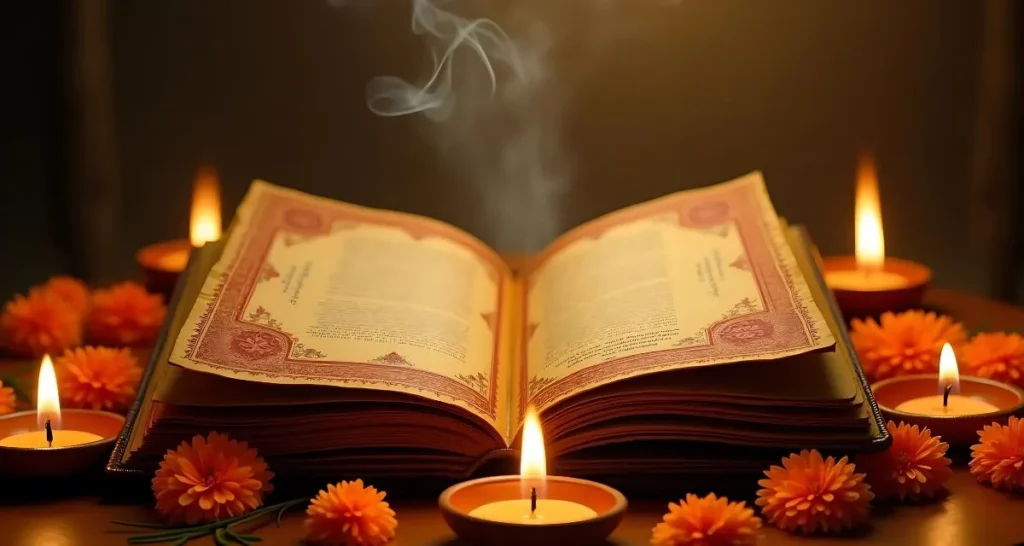Durga Saptashati is one of the most sacred texts in Hinduism. It holds a deep spiritual and cultural significance. The word Durga Saptashati, refers to a collection of 700 verses dedicated to Goddess Durga.

These verses are chanted during Navratri and other Durga Puja-related festivals to seek her blessings, protection, and strength. These verses are recited especially during Navratri and other significant festivals dedicated to the Divine Mother.
People believe that reading or listening to Durga Saptashati not only brings peace and prosperity but also removes fear, negativity, and all forms of obstacles from one’s life.
What is Durga Saptashati?
Durga Saptashati is also known as Devi Mahatmya or Chandi Path. It is part of the Markandeya Purana, an ancient Hindu scripture. The text is composed in Sanskrit and has 700 shlokas (verses), which is why it is called Saptashati (“sapta” means seven and “shati” means hundred).
It is divided into 13 chapters and tells the story of how Goddess Durga fought and defeated various powerful demons, including Mahishasura, Shumbha, and Nishumbha. These stories symbolize the victory of good over evil.

In Indian households, the text is often recited with devotion and discipline, forming an essential part of spiritual routines.
Saints and scholars have recommended it for anyone seeking courage, clarity, and spiritual evolution. Whether you are spiritually inclined or just curious about Hindu philosophy.
Durga Saptashati offers profound insight into the eternal battle between good and evil, and how divine energy always triumphs.
Origin and Composition
Durga Saptashati was written between 400-600 CE. It was included in the Markandeya Purana, attributed to the sage Markandeya. The text praises the divine feminine energy and portrays the Goddess as the ultimate protector and nurturer.
Below is a table summarizing the structure of Durga Saptashati:
| Section | Description |
|---|---|
| Chapters 1-3 | The story of Madhu and Kaitabha |
| Chapters 4-10 | The battle against Mahishasura |
| Chapters 11-13 | The war with Shumbha and Nishumbha |
Each section presents a different form of the Goddess and her unique powers.
Spiritual Meaning
Durga Saptashati is not just about mythology. It also has deep spiritual lessons. Each demon in the story represents a human weakness like ego, anger, greed, and jealousy. Goddess Durga defeating these demons symbolizes how divine energy can help us overcome these inner enemies.
By chanting or listening to Durga Saptashati, devotees believe they receive spiritual energy, inner peace, and mental clarity.
Importance During Navratri
Navratri is one of the most important festivals in Hindu culture. It is celebrated over nine nights to honor the nine forms of Goddess Durga. During these days, many devotees read or recite the Durga Saptashati.
It is believed that chanting these sacred verses during Navratri brings prosperity, good health, and protection from negative forces. Temples often conduct public readings, and households set up special altars to perform rituals.
Benefits of Reciting Durga Saptashati
Devotees believe that the Durga Saptashati has numerous benefits. Here are some of them:
| Benefit | Description |
| Protection | Shields the devotee from evil energies and negative thoughts |
| Inner Strength | Builds courage and mental resilience |
| Peace of Mind | Calms the mind and reduces stress |
| Spiritual Growth | Enhances devotion and spiritual awareness |
| Prosperity and Good Fortune | Attracts wealth and happiness |
How to Read Durga Saptashati
Reading Durga Saptashati should be done with devotion and respect. Here are some tips:

- Always start with a prayer and clean surroundings.
- It is traditionally read over 7 or 9 days during Navratri.
- Use a Sanskrit version with a reliable English translation if needed.
- Focus on the meaning and intention behind each verse.
- Avoid rushing through it. Read with calmness and devotion.
Some people choose to do a complete recital in one day, known as “Saptashati Path.” Others divide the chapters over multiple days.
Symbolism in Durga Saptashati
Each demon in the Durga Saptashati has a symbolic meaning:
- Mahishasura represents ego and ignorance.
- Shumbha and Nishumbha symbolize pride and arrogance.
- Madhu and Kaitabha represent confusion and doubt.
Goddess Durga’s weapons, like the sword, trident, and bow, symbolize different spiritual powers. Her lion represents determination and fearlessness.
Durga Saptashati in Modern Times
In today’s fast-paced life, stress and anxiety are common. Many people turn to spiritual texts like Durga Saptashati for peace and guidance.
Even those who do not understand Sanskrit find meaning in listening to the chants or reading translated versions. It helps in grounding the mind and building a spiritual routine.
Several apps and websites now offer audio recitations, translations, and guided readings, making it easier for young people to connect with the ancient text.
It’s Scientific View
Though Durga Saptashati is a religious text, chanting and meditation have been studied scientifically. Listening to rhythmic chants can reduce stress, improve focus, and even boost immunity.
The vibrations created by Sanskrit verses are believed to have a calming effect on the nervous system.
Final Thoughts
Durga Saptashati is not just a set of stories or rituals. It is a guide for self-growth, inner strength, and spiritual awakening. The text shows us that with devotion and belief, we can overcome any challenge in life.
Whether you are deeply religious or simply curious, exploring the Durga Saptashati can be a life-enriching experience. It connects us to our roots, our culture, and the eternal power of the divine feminine.
Make it a part of your spiritual journey and feel the difference it brings to your mind and soul.

